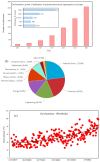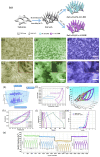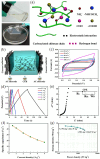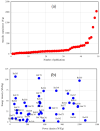A Comparison of the Electrical Properties of Gel Polymer Electrolyte-Based Supercapacitors: A Review of Advances in Electrolyte Materials
- PMID: 39727559
- PMCID: PMC11675368
- DOI: 10.3390/gels10120803
A Comparison of the Electrical Properties of Gel Polymer Electrolyte-Based Supercapacitors: A Review of Advances in Electrolyte Materials
Abstract
Flexible solid-state-based supercapacitors are in demand for the soft components used in electronics. The increased attention paid toward solid-state electrolytes could be due to their advantages, including no leakage, special separators, and improved safety. Gel polymer electrolytes (GPEs) are preferred in the energy storage field, likely owing to their safety, lack of leakage, and compatibility with various separators as well as their higher ionic conductivity (IC) than traditional solid electrolytes. This review covers the classification, properties, and configurations of different GPE-based supercapacitors and recent advancements that have occurred in this area of energy storage. Ionic liquid (IL)-based materials are popular GPEs for electrochemical energy storage and can be used to prepare unprecedented flexible supercapacitors due to their great IC and wide potential range. A comparative assessment of the GPEs-based supercapacitors reveals that in a majority of them, the value of specific capacitance is generally under 1000 F g-1, energy density reaches around 125 Wh kg-1, and the power density is seen to be less than 1500 W kg-1. The results of this research serve as an essential reference for upcoming scholars, and could significantly improve our comprehension of the efficacy of GPE-containing supercapacitors.
Keywords: PVA; gel polymer electrolytes; ionic liquids; supercapacitor.
Conflict of interest statement
The authors declare no conflict of interest.
Figures








Similar articles
-
Poly(3,4-ethylenedioxythiophene) Based Solid-State Polymer Supercapacitor with Ionic Liquid Gel Polymer Electrolyte.Polymers (Basel). 2020 Feb 2;12(2):297. doi: 10.3390/polym12020297. Polymers (Basel). 2020. PMID: 32024287 Free PMC article.
-
Poly(vinyl Alcohol) Borate Gel Polymer Electrolytes Prepared by Electrodeposition and Their Application in Electrochemical Supercapacitors.ACS Appl Mater Interfaces. 2016 Feb 10;8(5):3473-81. doi: 10.1021/acsami.5b11984. Epub 2016 Jan 29. ACS Appl Mater Interfaces. 2016. PMID: 26788748
-
All-solid-state flexible supercapacitors based on papers coated with carbon nanotubes and ionic-liquid-based gel electrolytes.Nanotechnology. 2012 Feb 17;23(6):065401. doi: 10.1088/0957-4484/23/6/065401. Epub 2012 Jan 17. Nanotechnology. 2012. PMID: 22248712
-
Gel/Solid Polymer Electrolytes Characterized by In Situ Gelation or Polymerization for Electrochemical Energy Systems.Adv Mater. 2019 May;31(20):e1804909. doi: 10.1002/adma.201804909. Epub 2018 Nov 2. Adv Mater. 2019. PMID: 30387233 Review.
-
Gel Polymer Electrolytes: Advancing Solid-State Batteries for High-Performance Applications.Gels. 2023 Jul 21;9(7):585. doi: 10.3390/gels9070585. Gels. 2023. PMID: 37504464 Free PMC article. Review.
References
-
- Behzadi G., Fekri L., Golnabi H. Effect of the Reactance Term on the Charge/Discharge Electrical Measurements Using Cylindrical Capacitive Probes. J. Appl. Sci. 2011;11:3293–3300. doi: 10.3923/jas.2011.3293.3300. - DOI
-
- Nazarpour-Fard H., Shirini F., Pour G.B. Heterogeneous Organic Reactions in the Presence of Poly (Vinyl Pyridine) and Its Derivatives as Catalyst or Reagent. Inorg. Chem. Commun. 2024;172:113691. doi: 10.1016/j.inoche.2024.113691. - DOI
-
- Behzadi G., Golnabi H. Monitoring Temperature Variation of Reactance Capacitance of Water Using a Cylindrical Cell Probe. J. Appl. Sci. 2009;9:752–758. doi: 10.3923/jas.2009.752.758. - DOI
-
- Ghaderi A., Sabbaghzadeh J., Dejam L., Behzadi Pour G., Moghimi E., Matos R.S., da Fonseca Filho H.D., Ștefan T., Salehi shayegan A., Fekri Aval L., et al. Nanoscale Morphology, Optical Dynamics and Gas Sensor of Porous Silicon. Sci. Rep. 2024;14:3677. doi: 10.1038/s41598-024-54336-x. - DOI - PMC - PubMed
Publication types
LinkOut - more resources
Full Text Sources
Miscellaneous

